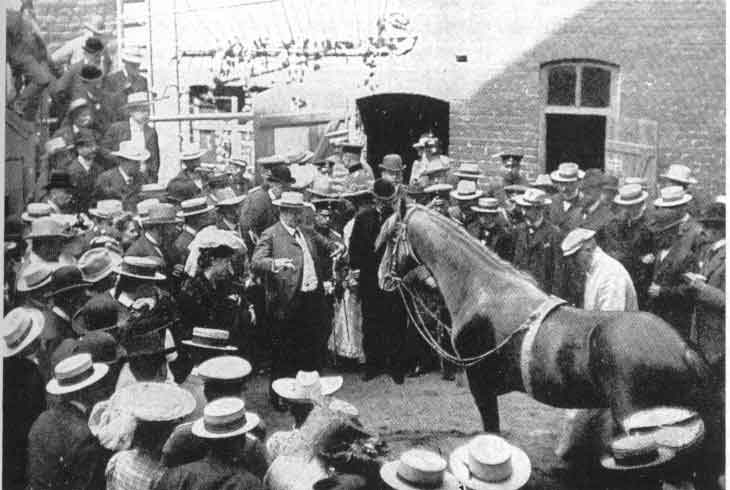steve_bank
Diabetic retinopathy and poor eyesight. Typos ...
I remembered this on another thread.

 en.wikipedia.org
en.wikipedia.org

Clever Hans - Wikipedia
Clever Hans (German: der Kluge Hans; fl. 1907) was a horse that was claimed to have performed arithmetic and other intellectual tasks. After a formal investigation in 1907, psychologist Oskar Pfungst demonstrated that the horse was not actually performing these mental tasks, but was watching the reactions of his trainer. He discovered this artifact in the research methodology, wherein the horse was responding directly to involuntary cues in the body language of the human trainer, who was entirely unaware that he was providing such cues.[1] In honour of Pfungst's study, the anomalous artifact has since been referred to as the Clever Hans effect and has continued to be important knowledge in the observer-expectancy effect and later studies in animal cognition. Pfungst was an assistant to German philosopher and psychologist Carl Stumpf, who incorporated the experience with Hans into his further work on animal psychology and his ideas on phenomenology.[2]
Investigation
The great public interest in Clever Hans led the German board of education to appoint a commission to investigate von Osten's scientific claims. Philosopher and psychologist Carl Stumpf formed a panel of 13 people, known as the Hans Commission. This commission consisted of a veterinarian, a circus manager, a cavalry officer, a number of schoolteachers, and the director of the Berlin zoological gardens. This commission concluded in September 1904 that no tricks were involved in Hans's performance.[2]
The commission passed off the evaluation to Oskar Pfungst, who tested the basis for these claimed abilities by:
Using a substantial number of trials, Pfungst found that the horse could get the correct answer even if von Osten himself did not ask the questions, ruling out the possibility of fraud. However, the horse gave the right answer only when the questioner knew what the answer was and the horse could see the questioner. He observed that when von Osten knew the answers to the questions, Hans got 89 percent of the answers correct, but when von Osten did not know the answers to the questions, Hans answered only six percent of the questions correctly.
- Isolating horse and questioner from spectators, so no cues could come from them
- Using questioners other than the horse's master
- By means of blinders, varying whether the horse could see the questioner
- Varying whether the questioner knew the answer to the question in advance.
Pfungst then examined the behaviour of the questioner in detail, and showed that as the horse's taps approached the right answer, the questioner's posture and facial expression changed in ways that were consistent with an increase in tension, which was released when the horse made the final, correct tap. This provided a cue that the horse could use to tell it to stop tapping. The social communication systems of horses may depend on the detection of small postural changes, and this would explain why Hans so easily picked up on the cues given by von Osten, even if these cues were subconscious.
Pfungst carried out laboratory tests with human subjects, in which he played the part of the horse. Pfungst asked subjects to stand on his right and think "with a high degree of concentration" about a particular number, or a simple mathematical problem. Pfungst would then tap out the answer with his right hand. He frequently observed "a sudden slight upward jerk of the head" when reaching the final tap, and noted that this corresponded to the subject resuming the position they had adopted before thinking of the question.[4]
Even after this official debunking, von Osten, who was never persuaded by Pfungst's findings, continued to show Hans around Germany, attracting large and enthusiastic crowds.[3]
The Clever Hans effect
After Pfungst had become adept at giving Hans performances himself, and was fully aware of the subtle cues which made them possible, he discovered that he would produce these cues involuntarily regardless of whether he wished to exhibit or suppress them. Recognition of this phenomenon has had a large effect on experimental design and methodology for all experiments whatsoever involving sentient subjects, including humans.
The risk of Clever Hans effects is one reason why comparative psychologists normally test animals in isolated apparatus, without interaction with them. However this creates problems of its own, because many of the most interesting phenomena in animal cognition are only likely to be demonstrated in a social context, and in order to train and demonstrate them, it is necessary to build up a social relationship between trainer and animal. This point of view has been strongly argued by Irene Pepperberg in relation to her studies of parrots (Alex), and by Allen and Beatrix Gardner in their study of the chimpanzee Washoe. If the results of such studies are to gain universal acceptance, it is necessary to find some way of testing the animals' achievements which eliminates the risk of Clever Hans effects. However, simply removing the trainer from the scene may not be an appropriate strategy, because where the social relationship between trainer and subject is strong, the removal of the trainer may produce emotional responses preventing the subject from performing. It is therefore necessary to devise procedures where none of those present knows what the animal's likely response may be.
The Clever Hans Effect has also been observed in drug-sniffing dogs. A study at University of California, Davis revealed that cues can be telegraphed by the handler to the dogs, resulting in false positives.[5]
A 2004 study of Rico, a border collie reported by his owners as having a vocabulary of over 200 words, avoided the Clever Hans effect by having the owner ask the dog to fetch items from an adjacent room, so that the owner could not provide real time feedback while the dog was selecting an object.
